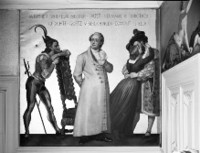 Playing Catch 22 with cultural heritage is quite simple: since cultural heritage institutions hardly ever are in a position to digitize their collection because of a lack of financial resources, they obtain funding on the basis of public/private partnerships.
Playing Catch 22 with cultural heritage is quite simple: since cultural heritage institutions hardly ever are in a position to digitize their collection because of a lack of financial resources, they obtain funding on the basis of public/private partnerships.
Chances are that in return for the financial support needed for digitization, the private party will seek to retain exclusivity over the digitized objects and to impose restrictions on their further reproduction and making available to the public. The result: the collection is certainly digitized, but the public’s expectation of being able to freely re-use digitized works remains frustrated for as long as the private party has decided.
European cultural heritage institutions regularly face Faust’s dilemma of concluding a pack with the devil to preserve their (collection’s) eternal youth. The French Ministry of Culture announced on 15th January the conclusion of such an agreement with two digitization and archival companies. In its press release entitled ‘Investments for the Future: Two major partnerships concluded for the digitization and dissemination of the collections of the Bibliothèque nationale de France (BnF)’, the Ministry explains that
The Bibliothèque nationale de France, which started fifteen years ago with the digitization of its heritage, also accelerates its activity in this area through the Investment Program for the Future, with the signing of the first two partnership agreements concluded by its subsidiary “BnF-Partnerships” created in 2012 to implement the establishment of partnerships between public and private actors in the digitization and dissemination of heritage artifacts.
The agreement with ProQuest, editor of cultural and historical research database, provides for the scanning of 70,000 French antique books dating from 1470 to 1700. The project involves all copies of incunabula printed before 1500 and by publishing a copy printed for the sixteenth and seventeenth century. The agreement with ProQuest is part of the European program “Early European Books,” in which four major European libraries participate, and which aims to create a virtual digital library bringing together key works before 1700. A selection of 3500 books, chosen by the BnF, will be immediately accessible for free through Gallica. As the scanning progresses, other digitized books will be accessible to all readers of the BnF for ten years before being released for free access through Gallica.
Partnerships with Believe Digital and Memnon Archiving Services concern a digitization project and development of nearly 200 000 78 LPs and 33 rpm. With these two partners, Believe Digital, a French company, European leader in the distribution of digital music, and Memnon Archiving Services, a company specializing in scanning, this project will make available on major digital music distribution platforms a unique offer of more than 700 000 titles across all genres (classical, jazz, and world music …)
Income from partnerships will be reinvested by the BnF in new digitization projects. These two agreements of public-private partnership are based on the recommendations made in recent years by several French or European reports on the development of digital heritage and its dissemination (Marc Tessier report on the digitization of the written heritage, report The New Renaissance commissioned by the European Commission, …). They are fully inscribed in the overall context of the active policy of digitization and dissemination desired and encouraged by Aurélie Filippetti, Minister of Culture and Communication.
In short, the two private companies will digitize over 270,000 items in the BnF collection that are in whole or in part in the public domain – including rare antique books. The outcome: the general public, including scholars and researchers, will gain immediate free online access to only 1,3 % of it. For the rest, consultation is only permissible on the premises of the Bibliothèque until the expiration of the 10 year embargo period set in the agreement. Contrary to what the press release says, this agreement is not in line with the recommendations of the New Renaissance report. In the section on public/private partnerships, the report clearly states that
The digitised public domain material should be free of charge for the general public and available in all EU Member States.
(…) The maximum time of preferential use of material digitised in public-private partnerships must not exceed 7 years.
These agreements are also in direct contradiction with the Public Domain Charter published by the Europeana Foundation in 2011.
Sadly, this type of arrangement is not unique to France nor to the Bibliothèque nationale de France. Too many institutions across Europe have been literally forced to conclude similar agreements to get funding for their digitization projects. Where such arrangements could be more easily defended for works that are still protected by copyright (either in the case of out-of-print or orphan works), they generate outcry when they concern works in the public domain.
As the authors of the New Renaissance report emphasized
entering into a partnership with a private entity should not result in compromising the core mission of cultural institutions, but rather further allow them to reap the full benefits from the digitisation of their collections in terms of online accessibility, preservation and re-use.
Let’s imagine ways to break free from the Catch 22 game!
________________________
To make sure you do not miss out on regular updates from the Kluwer Copyright Blog, please subscribe here.



On the bottom line one needs to ask the questions ‘Who will finance digitization in Europe?’ It is quite clear that public funds alone are insufficient to achieve this and in this scenario private sector involvement (naturally with exclusivity over the digitized material) is unavoidable. What Europe needs now is a comprehensive and realistic framework to ensure that digitization and private sector involvement in digitization continues, albeit with checks and balances, so that the rights of the public to this patrimony are preserved as much as possible.